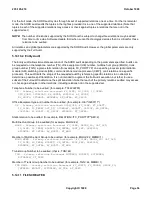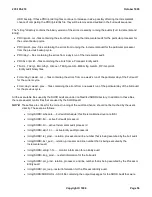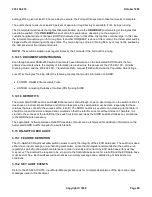
Some of the main events for the On-Switch ECD Audit are as follows:
Scheduling: Schedule automatic execution of the Audit for routine maintenance. (SCHED:ECDAUD)
Running: Manual or Automatic execution of the audit. (EXC:ECDAUD)
Stopping: Input of the stop command will abort execution of a currently running audit. (STOP:ECDAUD)
Inhibiting: Input of the inhibit command will keep the scheduled audit from running and also prevent manual
execution of the audit until the allow command is entered. (INH:ECDAUD)
Allowing: Input of the allow command will let the scheduled audit run and also allow manual execution of the
audit after it has been previously inhibited. (ALW:ECDAUD)
Checking Audit Status: Input of the status command will show the current status of a running audit or the status
of the last execution of the audit. (OP:ECDAUD)
5.15.3 USER PERSPECTIVES
The following lists the user interfaces provided with the feature:
When the audit is first deployed in an office, it will create a default schedule for routine maintenance.
The user can enter input commands to inhibit and allow the audit.
An input message is provided to request immediate execution of the audit.
An input message is provided to determine the current status of the audit.
A summary message indicating how many errors were detected is provided after the conclusion of each audit
execution.
An input message is provided to stop audit execution at any time.
5.15.4 SCHEDULING THE AUDIT
To schedule the audit for weekly execution, the following input message should be used:
SCHED:ECDAUD:STARTTIME=a-b,c;
Where:
a = Hour of start time (0-23)
b = Minute of start time (0-59)
c = Day of start (MON, TUE, WED, THU, FRI, SAT, SUN)
To schedule the audit for monthly execution, the following input message should be used:
SCHED:ECDAUD:STARTTIME=a-b,d;
Where:
d = Day of Month start time (1-28)
To verify the current schedule, the following input message should be used:
OP:ECDAUD
5.15.5 RUNNING THE AUDIT
235-105-210
October 1999
Copyright © 1999
Page 60
Summary of Contents for 5ESS-2000
Page 96: ...235 105 210 October 1999 Copyright 1999 Page 2 ...
Page 184: ...235 105 210 October 1999 Copyright 1999 Page 3 ...
Page 300: ...13 STOP YOU HAVE COMPLETED THIS PROCEDURE 235 105 210 October 1999 Copyright 1999 Page 55 ...
Page 339: ...7 STOP YOU HAVE COMPLETED THIS PROCEDURE 235 105 210 October 1999 Copyright 1999 Page 13 ...
Page 342: ...235 105 210 October 1999 Copyright 1999 Page 2 ...
Page 359: ...235 105 210 October 1999 Copyright 1999 Page 5 ...
Page 609: ...2 STOP YOU HAVE COMPLETED THIS PROCEDURE 235 105 210 October 1999 Copyright 1999 Page 12 ...
Page 676: ...235 105 210 October 1999 Copyright 1999 Page 9 ...
Page 792: ...3 STOP YOU HAVE COMPLETED THIS PROCEDURE 235 105 210 October 1999 Copyright 1999 Page 9 ...
Page 799: ...Figure 11 36 3 1 Cleaning Points 235 105 210 October 1999 Copyright 1999 Page 7 ...
Page 801: ...235 105 210 October 1999 Copyright 1999 Page 9 ...
Page 839: ...2 STOP YOU HAVE COMPLETED THIS PROCEDURE 235 105 210 October 1999 Copyright 1999 Page 16 ...
Page 999: ...2 STOP YOU HAVE COMPLETED THIS PROCEDURE 235 105 210 October 1999 Copyright 1999 Page 13 ...
Page 1008: ...Figure 11 55 1 CTSNS DIP Switch Settings 235 105 210 October 1999 Copyright 1999 Page 2 ...
Page 1011: ...235 105 210 October 1999 Copyright 1999 Page 5 ...
Page 1053: ...235 105 210 October 1999 Copyright 1999 Page 15 ...
Page 1289: ...Figure 15 17 2 AMATPS Data Link 235 105 210 October 1999 Copyright 1999 Page 2 ...
Page 1292: ...235 105 210 October 1999 Copyright 1999 Page 5 ...
Page 1303: ...9 STOP YOU HAVE COMPLETED THIS PROCEDURE 235 105 210 October 1999 Copyright 1999 Page 2 ...
Page 1360: ...Figure 15 47 2 Typical SCANS III Link Diagram 235 105 210 October 1999 Copyright 1999 Page 2 ...
Page 1372: ...235 105 210 October 1999 Copyright 1999 Page 2 ...
Page 1374: ...235 105 210 October 1999 Copyright 1999 Page 4 ...
Page 1421: ...Table 1 1 O M Checklist 235 105 210 October 1999 Copyright 1999 Page 3 ...
















































